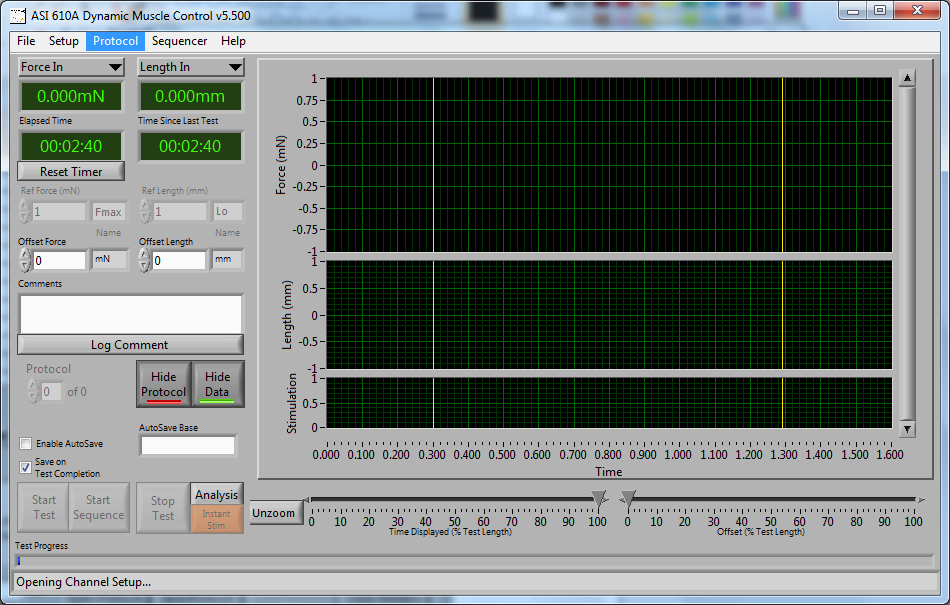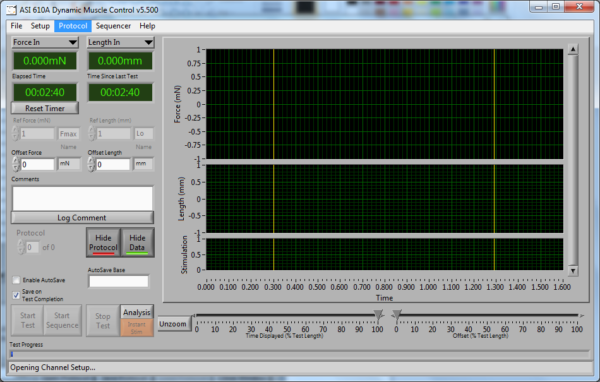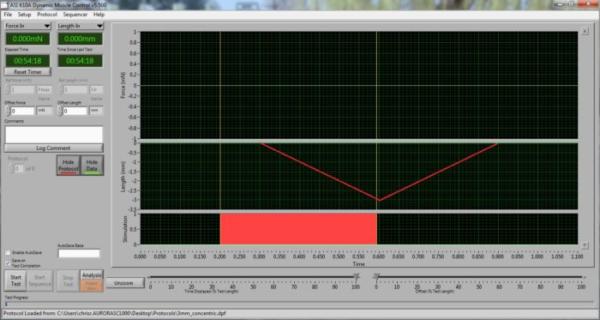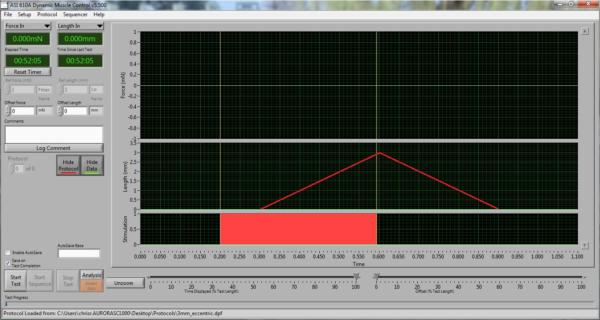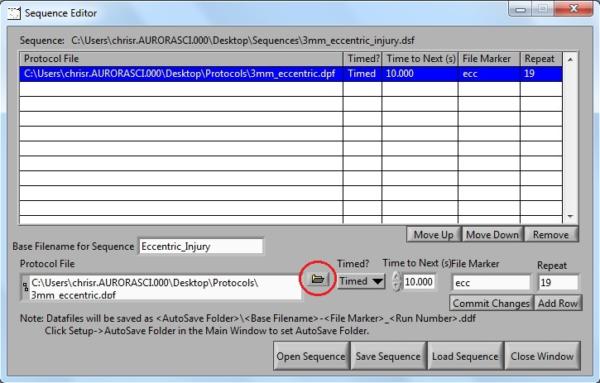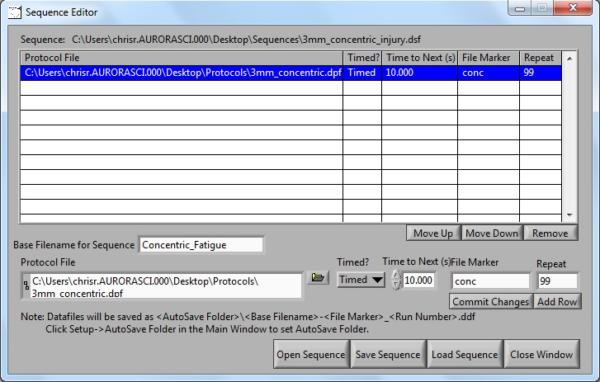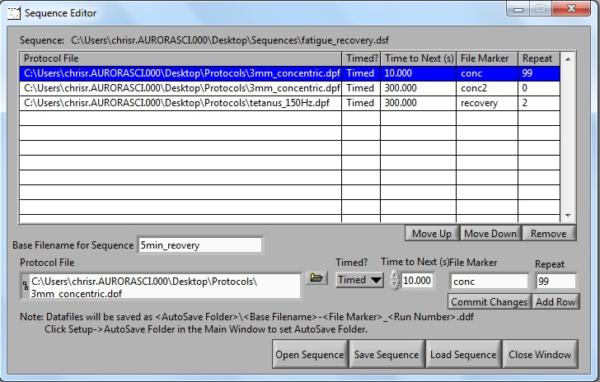Are you looking to go beyond isometric with your animal model? We can help!
In this second installment of our series of blogs, “How to Write Basic Protocols in DMC,” we will outline how to write basic lengthening and shortening protocols to perform eccentric and concentric contractions. Many researchers employ these types of experiments to induce muscle injury and/or fatigue. These protocols more closely model real world exercise and work as opposed to isometric protocols.
If you’d like to learn how to write and perform a basic twitch or tetanus protocol, or get an overview of key terms you’ll encounter using 615A Dynamic Muscle Control and Analysis Software, check out our first installment, “How to Write Basic Protocols in DMC – Isometric,” for detailed step-by-step instructions.
Jump to:
Concentric
Eccentric
Injury
Fatigue
Concentric
In contrast to an isometric contraction which results in force development (tetanus) in the absence of a change in muscle length, a concentric contraction develops force while the muscle shortens. This type of contraction is used numerous times a day, whether simply getting out of bed or lifting a mug for a sip of your morning coffee.
Researchers employ this type of contraction in order to model physiologically relevant exercise in animals as well as utilizing it to induce injury-free fatigue.
The following protocol is designed to elicit a concentric contraction from individual muscle preparations in-vitro or in-situ as positive values cause the 300C Dual-Mode lever system to rotate counter-clockwise. In addition, the protocol will induce a concentric contraction for plantarflexors (i.e., soleus, gastrocnemius, plantaris) when used in-vivo. However, it is recommended you change the length channel units to degrees (°) and force units to torque (i.e., mN-m) when performing in-vivo experiments.
NOTE: This protocol elicits an ECCENTRIC contraction for dorsiflexors (i.e., Tibialis Anterior, Extensor Digitorum Longus) when used in-vivo.
To begin, open the protocol editor found at the top of the main window of Dynamic Muscle Control (DMC).
Key Terms:
‘Ramp’ – Length or Force change over a set period of time
‘Value to Ramp to’ – value you wish to change length or force to in channel display units (e.g., 3 mm)
‘Time’ – amount of time it takes for the motor to reach the ‘value to ramp to’Below are the steps required to write a basic concentric protocol:
- enter 0 for ‘Wait’
- choose ‘Stimulus – Tetanus’ from action drop down menu
- in the parameters box, enter the following, 0.2, 150, 0.2, 0.4
- select ‘Add Row’
- enter 0.3 for ‘Wait’
- choose ‘Ramp’ from action menu (Length Out will automatically be selected)
- in the parameters box, enter the following: 3, 0.3
- select ‘Add Row’
- enter 0 for ‘Wait’
- choose ‘Ramp’ from action menu (Length Out will automatically be selected)
- in the parameters box, enter the following: 0, 0.3 (muscle passively returns to Lo)
- select ‘Add Row’
- enter a stop command, with a ‘Wait’ of 0.2s and select ‘Add Row’
- save protocol (e.g., 3mm_concentric)
Figure 2. An example of a concentric contraction protocol with a 3mm shortening, written using the protocol editor.
Figure 3. DMC software screen shot depicting a 3mm concentric shortening protocol on the length channel.Note: ensure you remove the values in the parameters box prior to adding a stop command.
Eccentric
As opposed to a concentric contraction where the muscle shortens in response to stimulation, an eccentric contraction results in the muscle lengthening or stretching while contracting. A real life example of this would be running downhill or lowering a heavy object to the floor by bending your legs.
This type of contraction is often used to induce injury in the muscle(s) when repeated many times in quick succession. With many muscle disease models showing increased fatigability and reduced injury recovery, researchers use this as a valuable tool to compare levels of muscle damage, fatigue and recovery (when used in-vivo) between wildtype and disease animals.
The following protocol is designed to elicit an eccentric contraction from individual muscle preparations in-vitro or in-situ as negative values cause the motor to rotate clockwise. In addition, the protocol will induce an eccentric contraction for plantarflexors when used in-vivo.
NOTE: This protocol elicits a CONCENTRIC contraction for dorsiflexors when used in-vivo.Below are the steps required to write a basic eccentric protocol:
- open concentric protocol from above (ex. 3mm_concentric)
- click on the second line of the protocol
- in the parameters box, enter the following: -3, 0.3
- select ‘Commit Changes’
- save Protocol (e.g., 3mm_eccentric)
Figure 4. An example of an eccentric contraction protocol with a 3mm lengthening, written using the protocol editor.
Figure 5. Software screen shot depicting a 3mm eccentric stretch protocol on the length channel.
Injury
Utilizing the eccentric protocol, researchers can write an eccentric injury sequence to perform numerous and rapid muscle lengthening contractions in order to induce sufficient muscle damage. Following injury, you’re capable of measuring inflammatory response, long term (in-vivo) and short term (in-situ and in-vitro) recovery, fatigability and many others.Now that you have your eccentric protocol written, open the sequence editor by clicking on ‘Sequence’ at the top of the main DMC window.Using the sequence editor:
- open a protocol by clicking on the folder icon (circled in red), select your eccentric protocol (i.e., 3mm_eccentric)
- enter a ‘time to next’ of 10s
- in the ‘File Marker’ box, enter a unique tag to associate the data with a specific protocol (e.g., ecc)
- enter 19 repeats (20 total contractions) to induce sufficient muscle injury. (Note: in-vivo eccentric injury often requires many more repetitions to induce sufficient muscle damage (i.e., 50-100)
Figure 6. An example of an eccentric injury sequence consisting of 20 contractions with 10 seconds between each, written using the sequence editor. Folder icon circled in red.
- click ‘Add Row’
- enter a ‘Base Filename for Sequence’ to associate your data with this particular sequence. (e.g., Eccentric_Injury)
- save sequence (e.g., 3mm_Eccentric_Injury)
Fatigue
The overwhelming majority of protocols used in the literature employ numerous isometric contractions to induce muscle fatigue. However, this type of muscle fatigue does not correspond to the real life fatigue seen when we exercise, which results from a combination of concentric and eccentric contractions. A published example of a concentric protocol used to induce fatigue can be found in “Causes of fatigue in slow-twitch rat skeletal muscle during dynamic activity.”
Now that you have your concentric protocol written, you’re ready to write a fatigue sequence utilizing the concentric protocol.
Open the sequence editor at the top of the main DMC window.Using the sequence editor:
- open your concentric protocol (i.e., 3mm_concentric)
- enter a ‘Time to Next’ of 10s
- in the ‘File Marker’ box, enter a unique tag (e.g., conc)
- enter 99 repeats (100 total contractions) to induce sufficient muscle fatigue
- click ‘Add Row’
- enter a ‘Base Filename for Sequence’ (e.g., Concentric_Fatigue)
- save sequence (e.g., 3mm_Concentric_Fatigue)
Figure 7. An example of a concentric fatigue sequence consisting of 100 contractions with 10 seconds between each, written using the sequence editor.In order to measure fatigue recovery many researchers run a single isometric tetanus at various time points following the last concentric contraction. This can be done by manually running a single isometric tetanus protocol at specified time points (e.g., 5, 10, 15 minutes) following the fatigue sequence or by building it into the sequence.To add a recovery tetanus into the concentric fatigue sequence:
- select row, change the number of repeats to 98 and click ‘Commit Changes’
- select row, change the ‘Time to Next’ to be 300s (i.e., 5 minutes) and the number of repeats to 0
- enter a unique ‘File Marker’ (e.g., conc2), ‘Add Row’
- click the folder icon and open your 150Hz tetanus protocol
- enter a ‘Time to Next’ of 0 if you wish to perform only 1 recovery tetanus, if you would like to repeat enter the delay time between repeats (e.g., 300s)
Figure 8. An example of a concentric fatigue sequence with 3 recovery tetani at 5, 10 and 15 minutes after the last concentric contraction, written using the sequence editor.
- enter number of repeats desired (e.g., 2 for 5, 10 and 15 minute recovery tetanus)
- enter unique ‘File Marker’ (e.g., recovery), ‘Add Row’
- enter ‘Base Filename for Sequence’ (e.g., 5min_recovery)
- ‘Save Sequence’ (e.g., fatigue_recovery)
Now that you’ve written your basic concentric and eccentric protocols and sequences in DMC, you’re ready to go beyond isometric with your muscle preparation!
If you’d like to learn how to control muscle length using reference units as opposed to unitized, check out our previous blog post.Control Muscle Length with DMC Software Using Reference Units
Published Examples
Interested in how these concentric and isometric protocols are being employed by muscle physiologists? Here are a few published examples:
Oxidative Capacity and Fatigability in Run Trained Malignant Hyperthermia Susceptible Mice
Utility of 17 – (allylamino) – 17 – demethoxygeldanamycin treatment for skeletal muscle injury

